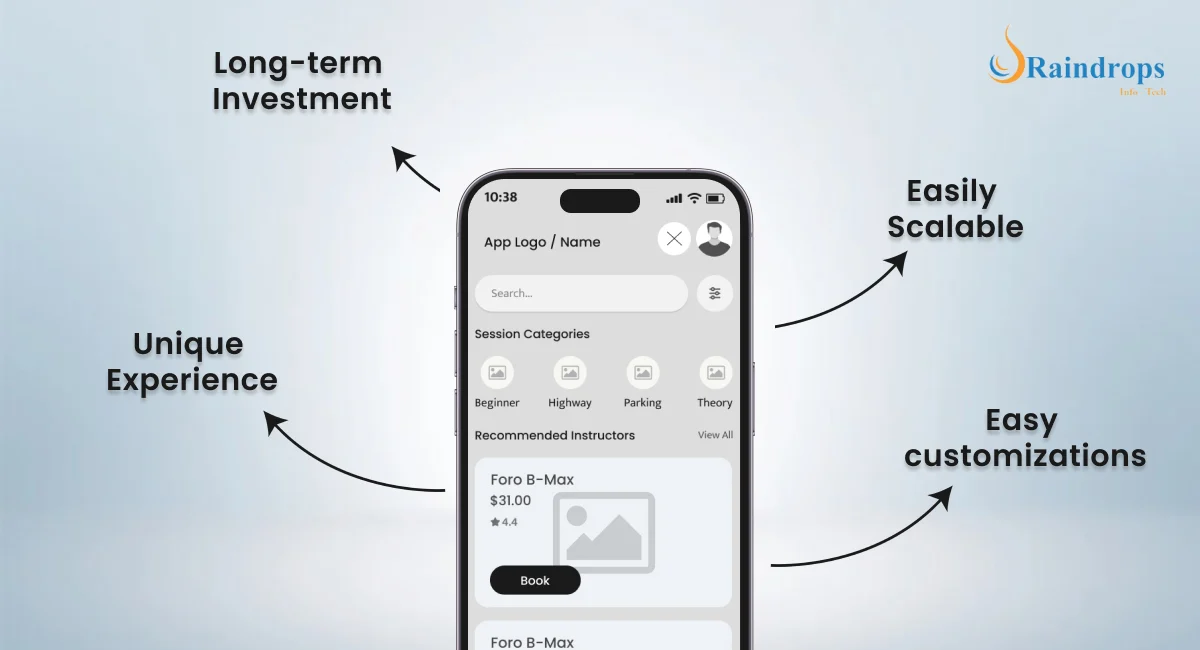E-commerce App: White Label Solution or Custom-Built apps?
Thinking about launching your business app? The first big question you’ll face is whether to go with a white-label solution or build your app from scratch. This is like deciding whether to choose a furnished apartment or to build a house brick by brick. This decision is more than just a starting point—it’s the foundation that will shape your budget, brand identity, and overall growth. So, how to choose the one best for your business?
“The secret of getting ahead is getting started.” So respecting Mark Twain’s words, without wasting any time let’s understand which option is suitable for your business:

White Label vs. Custom-Built
To start, it’s essential to understand the core differences between these two approaches:
White Label Solution: A white-label solution is a pre-built e-commerce platform that you can rebrand as your own. It’s like buying a pre-constructed house—you can move in quickly, but the structure and layout are already set. Customization is usually limited to aesthetics like colours, and logos.
Build Your Own: Custom e-commerce app development means starting from scratch. You design, develop, and build every feature and aspect of the platform. This is done according to your specific business needs. This is quite similar to constructing a house brick by brick, with full control over every detail. But it requires more time, effort, and investment.
Why should you consider White Label Solution?
White-label e-commerce solutions have gained popularity for a variety of reasons. Businesses who want to launch their app without any extra pain and huge financial investment associated are the ones turning towards this solution.
1. Comparatively Fast :
“The early bird catches the worm”. E-commerce is the most dynamic field, and this fact is not hidden from the world anymore. So, having the advantage of launching fast is of great importance. White-label solutions allow your site to be live in just weeks—sometimes even days. This enables you to get a ‘first-mover advantage’ in this ever-changing competitive market. This factor can be a game changer, considering how competitive the market has become.
2. Cost-Effective :
Who doesn’t care about money? Especially when you invest in something as important as your business. Remember, every penny counts. White-label solutions typically come with a lower initial cost compared to custom ecommerce development. Since the e-commerce software is already developed, you avoid the potential expenses associated with custom e-commerce app development. This makes white-label solutions an attractive option for startups or small businesses working with limited budgets.
3. User-Friendly :
I stand by Martin Leblanc for his statement—“A user interface is like a joke. If you have to explain it, it’s not that good”. This is one of the very important factors while considering either of the two options. User Friendliness is the core of any website, so one has to make sure that it is done right. And we know that not every business owner is a tech expert, and that’s perfectly fine. White-label platforms are designed to be user-friendly, with their features that are quite easy to use. This means you can manage your online store without needing to hire a developer or learn complex coding. Moreover, these platforms usually come with customer support, so help is readily available if you face any issues.
4. Time Saving :
As already mentioned, the technical part is mostly taken care of by professionals. This means you can focus on other really important stuff which mostly includes building your brand and connecting with customers. White-label solutions will give you more time for marketing strategies and development of your products without worrying so much about how to make apps. Time management at its best, isn’t it?
Why should you consider building your own app?

Simon Sinek wasn’t wrong when he said, “People don’t buy what you do, they buy why you do it.” While white-label solutions offer convenience, building your own e-commerce app gives that unique and personal touch to your brand. After all, in the end, it’s about making a difference in people’s lives. Make sure your personal touch is part of that difference.
So, now that you understand the importance of personalization, let’s answer another real question- ‘Why should you consider custom e-commerce app development?”
1. You Can Customise It Accordingly :
When you build your own app, you’re not limited by the boundaries of a pre-designed site. There is no structure or framework that needs to be followed. It is your site, so you are going to decide its fate—from the beginning till the end! You can design features and functions that align with your business goals and customer needs. A custom-built app allows you to create exactly what you need.
2. Comparatively Scalable :
The more your company grows, the greater your needs will be. Custom-developed applications can scale to more traffic and a growing product line. You won’t be held back by someone else’s platform limitations, which can sometimes interfere with your growth and requirements.
3. Unique Experience :
As already mentioned above, there is no alternative to personal touch. Uniqueness is what sets you apart from the crowd. In an e-commerce market that’s high with competition, offering personalised user experiences can give you an edge over the rest. With a custom app, you will be able to model every step of its user journey right from its homepage to checkout. This will ensure that your customers get a smooth and unforgettable experience. This level of personalization can increase customer loyalty and repeat business.
4. Long-Term Investment :
As already mentioned, the technical part is mostly taken care of by professionals. This means you can focus on other really important stuff which mostly includes building your brand and connecting with customers. White-label solutions will give you more time for marketing strategies and development of your products without worrying so much about how to make apps. Time management at its best, isn’t it?
“Time is your friend; impulse is your enemy.” – John Bogle
Although building an app from scratch requires high initial investment, the long term returns are fruitful. You are basically investing in the future. Choosing this option, you have full control over updates, changes, and improvements without relying on an external provider. In the long run, this will help save money by avoiding continuous licensing fees or other limitations of a third-party platform.
Customization or Convenience: What Matters Most to You?
Ultimately, it comes down to what matters most for your business: customization with custom e-commerce development or convenience that comes with a white-label solution. On one hand, if you need to get to market quickly and don’t require extensive customization, a white-label solution might be the best fit for you. But if you have very particular needs and long-term goals that require a much specific approach, building your app would likely be the better choice.
The choice between a white-label solution and the development of an e-commerce application from scratch is one that affects the business’s future. You should therefore consider your budget, timeline, technical expertise, and how much customization your needs require.
How about working with both choices?
For many businesses, choosing between a white-label solution and a custom-built app isn’t always straightforward. A hybrid approach could provide a balance, combining a white-label e-commerce platform with the flexibility to introduce custom e-commerce features as your business grows – just like it happens in custom built app development processes.
Begin with a white-label e-commerce platform, and you can get your online store up right away at an affordable cost. This process enables one to enter the market quickly without much initial investment. As your business grows, you learn more about what your customers want, and then eventually you can integrate features that make your platform more functional and user-friendly.
This hybrid approach gives you the best of both worlds—you can run it in a cost-effective manner and enjoy a flexible approach that will evolve and change with time. You’re not tied to any one solution. You start with a field-tested, ready-to-use platform and then, over time, transition to more specific approaches as needed.This is just the perfect blend to kickstart the development of your app.
So what’s the bottom line?
If you’re still unsure, it might be worth consulting with a professional who can guide you through the process and help you make the best choice for your business. At Raindrops Infotech, we understand that every business is unique. Whether you’re leaning toward a white-label solution or considering custom e-commerce app development, our team is here to help you navigate the complexities of e-commerce software. So why wait, let’s discuss how we can create the perfect e-commerce solution for your needs!



